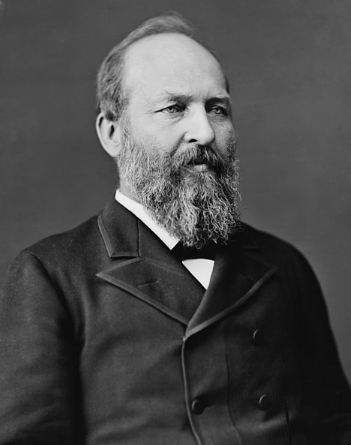Eventually, his mother remarried in 1842 but did not end up well and decided to divorce. As he was poor and fatherless, James was bullied by other children because of his sensitivity. He found refuge by reading whatever book he found.
When James Garfield was sixteen years old, he left home to work but was rejected by Cleveland’s only port. Instead, he drove canal boat teams and saved up for his education. James Garfield attended the Western Reserve Eclectic Institute in 1851 to 1854 then transferred to Williams College. He was known to excel in academics and shown significant interest in language, mainly Greek and Latin. James soon appreciates the power of a speaker over an audience. After he graduated from Williams College in 1856, he returned to Eclectic Institute to teach and work as an administrator.
He used his spare time productively but speaking publicly to support the Republican Party and abolition. In 1858, he married Lucretia Rudolph, who was his former student and had seven children together, wherein, two died in infancy.
James Garfield began to study law in 1859, overlapping with his blossoming career in politics as he won the Ohio State Senate position and served until 1861.
As the American Civil War broke, James Garfield was commissioned as a lieutenant colonel in the Union Army. He assisted in recruiting the 42nd Ohio Volunteer Infantry. He even commanded a brigade during the Battle of Shiloh and was elected to the House of Representatives. After another victory, he was promoted to major general and was distinguished at the Battle of Chickamauga in September 1863.
James Garfield was far from flawless and had his share of controversies. He had an extramarital affair with Lucia Calhoun, where he confessed to his wife and was forgiven. Many historians claimed that the letters James set to Lucia were seized and destroyed.
Throughout his political career, James Garfield represented Ohio’s 19th district for nine terms. He was also appointed as the House Committee on Appropriations, which made him an expert, particularly in fiscal matters, and implement a high protective tariff. Being a Radical Republican, James Garfield wished for a strict Reconstruction policy towards the states who seceded and subsequently supported Andrew Johnson’s impeachment because of his lenience towards the South. Eventually, he was elected as a United States Senator.
James Garfield was nominated as the presidential candidate of the Republicans and won against the Democratic nominee, General Winfield Scott Hancock, by a margin of 10,000 popular votes.
As he was inaugurated, James Garfield vowed to focus on the cause of civil rights and improve African Americans’ lives through education. He even appointed several former slaves such as Frederick Douglas. During his tenure as president, he strengthened Federal authority.
As he submitted his appointees to the Senate, Stalwart Republicans, Senator Roscoe Conkling, contested the nomination of his rival, William Robertson, to serve for the Customs House. He attempted to convince the Senate to dismiss it, but James Garfield would not submit and still had it his way.
Aside from the conflicts and domestic policies, in 1882, James Garfield’s Secretary of State hosted a conference and invited all American republics to meet in Washington; however, a meeting never took place.
On July 2, 1881, Charles J. Guiteau, an embittered attorney, grew resentful over the numerous denials to his request for a consular post shot the president twice in the railroad station in Washington D.C. James Garfield only served for four months in the office. The 39-year-old gunner immediately surrendered to the authorities, and calmly announced, “I am a Stalwart. Arthur is now president of the United States.”
The first shot to James Garfield only grazed his arm; however, the second bullet was a fatal shot that pierced his back and wedged his pancreas.
During the era of unawareness about the importance of sterilizing and the danger of sepsis, the doctors were not able to remove the bullet in James Garfield’s body. They even used the invention of Alexander Graham Bell, the metal detector.
The failure to remove the bullet caused the president’s body to be ridden with infection. James Garfield lay ill for 80 days. In his brief service, he signed the only act, the extradition paper, which stipulates his agreement that the vice president will assume the powers and duties of the president’s office. The vagueness of the Constitution caused the opinions to be divided. The cabinet members wish to consult James Garfield, but it was too late. No action was further taken before his death on September 19, 1881, attributed by blood poisoning, massive bleeding, and a cardiac arrest.
US Presidents | ||

